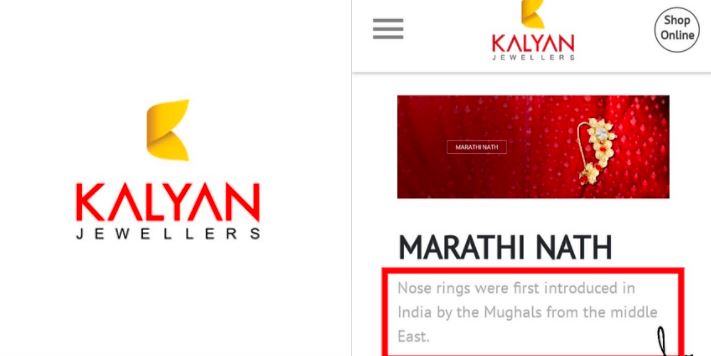One of the biggest travesty that the current generation of India would face is that they will grow up thinking that India’s culture and heritage are owed to the marauding and tyrant Mughal Empire. The textbooks have an excessive focus on the Mughal dynasty with the likes of Shivaji Maharaj, Chola dynasty and the Maurya Empire barely finding mention as a footnote. In a fresh controversy, Kalyan Jewellers, in one of its blogs on its website claimed that nose rings were introduced for the first time in India by the Mughals – which is nothing but pure hokum as nose ring was worn by Goddess Sita and is a part of the sixteen shringars of Hindu women. After outrage on social media, Kalyan Jewellers quickly corrected its mistake.
One of India’s largest jewellery chain, Kalyan Jewellers committed a major blunder, claiming that nose rings were first introduced in India by the Mughals. The company claimed, “Nose rings were first brought in India by the Mughals from the Middle East.”
It was Twitter user Sunaina Holey who pointed out the blunder as she shed light on how the Marathi nath’s page of Kalyan Jewellers’ website wrongly attributed the introduction of nose rings to Mughals.
Sunaina Holey tweeted, “Nath Or Nose Rings weren’t introduced by Mughals in India. Please don’t twist the history. It exists since ancient times & became popular around the 9th & 10th centuries, when naths became a status symbol. Requesting you to write facts.”
Hello @KalyanJewellers,
Nath Or Nose Rings weren't introduced by Mughals in India.
Please don't twist the history.It exists since ancient times & became popular around the 9th & 10th centuries, when naths became a status symbol.
Requesting you to write facts. pic.twitter.com/WbBAK45bUi
— Sunaina Holey ( Modi Ka Parivar ) (@SunainaHoley) June 26, 2021
Another Twitter user Saumya Mishra, cited historical references to bust Kalyan Jewellers’ claims as she stated that nose rings were a part of 16 shringars (makeup) used by the Hindu women. She tweeted, “It was present even before Muslims came into existence.”
Credit where due, Kalyan Jewellers was quick to respond to the controversy as while responding to Holey’s tweet, the jewellery maker stated, “Thank you for bringing this to our notice. We have updated the blog and corrected this error.”
Thank you everyone who shared the tweet & replied with facts below it. Zero abuse, no hashtag only facts.
WE DID IT ❤On social media it's never a one man army. It's a team effort!
Thanks @KalyanJewellers for correction. Please recheck other blogs too & correct the mistakes 🙏 pic.twitter.com/ElU3krzGbT
— Sunaina Holey ( Modi Ka Parivar ) (@SunainaHoley) June 27, 2021
Earlier in 2020, as the nation geared up to celebrate the pious festival of Navratri, a couple of brands dominated the national headlines displaying their complete lack of understanding of the Indian market as their festive advertisements managed to infuriate a large chunk of the country.
Tanishq kicked off the festivities with an advertisement which was supposed to project oneness in all religions, however, it ended up backfiring gloriously as Tanishq had to later remove the advertisement – which was nothing but a foolish experiment far from the truth and it was only natural for the Hindus suffering the stigma of love jihad to protest.
However, Tanishq, while removing the advertisement, took potshots at the Hindu community by stating that it wants to keep its employees, staff and partners safe. It was as if Hindus are vengeful goons who will go on a hunting spree if anyone dares offend their sentiments. Whereas the reality is that Hindus have been the beacons of tolerance since the beginning of time.
Eros Now, on the other hand, had gone for the completely indefensible by attempting to besmirch the pious festival of Navratri through its vulgar attempt at moment marketing. Eros Now urged people to “get naughty” this Navratri through its double meaning posts.
In the era of social media, it is becoming increasingly difficult for brands to escape scot-free with historically incorrect information and are getting thrashed left, right and centre.
